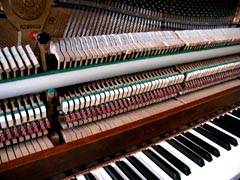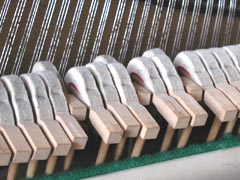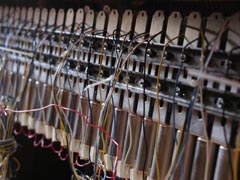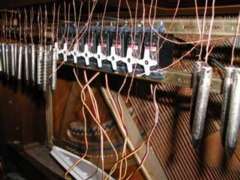Networked Piano
From 2001 to 2003 I had a piano in my office at ITP, which I worked to connect to the internet, in order to sonify the network traffic. The project did not work out as I had planned. What follows is the documentation of the project from 2002, with additional comments in retrospect.
So what was the piano in your office for?

At the moment, I’m making an internet-aware player piano. I’m not a pianist, nor do I play one on TV, which is a small problem.
The idea began as a discussion among the Interval fellows about the activity at ITP. There’s a very active community of students working on tons of different projects, many in collaboration with one another. But, outside of the times they’re talking together in the halls or the lounge, you’d never know it. Mostly they’re huddled in front of computer screens or over work benches. The lack of large physical activity belies the amount of mental and network activity. So we decided to work on a few projects to embody part of that, the network activity. The idea was to find ways to physically represent the activity of the network, to give visitors a feeling that something’s happening, and of the general pattern of activity.

The mechanics of a piano are beautiful to me, and the action of the keys, hammers, and dampers on the strings is great to watch; even more so in the case of a player piano, when the keys move in a ghostly way, with no apparent player. Since there are about 90 computers on the floor in use for various purposes, I decided I’d start by mapping those computers one-to-one to the keys of a piano. Any network-related activity coming from or going to that computer would play a given key on the piano. Of course, I expect that to make a horrible noise.

How will it make music?
At this stage (2002), the piano is half-assembled in my office at the moment. I built a system of solenoids for pulling the keys (sort of a reverse vorsetzer), and the electronics to control the solenoids, and a network analyzer to pass information to the controller. The solenoids didn’t work out so well. First, they consumed a huge amount of power. Second, they could only pull the key all the way down, or not at all. This meant I didn’t have any dynamic range on the notes I wanted to play. Third, they were slow. It took almost three quarters of a second from the time I triggered a note until it played. Unless I wanted to play very slow songs, this wouldn’t work.
Next I tested servomotors in place of the solenoids. They gave me much better control. I had limited dynamic range with them, and response time was much faster as well. The servos make a characteristic sound that would have to be incporporated as part of the overall sound of the instrument as well.

As I worked on the mechanics of the whole thing, other applications of the system came to me. Several people have written algorithms to map network traffic to musical composition, so I know there’s a way to get something reasonably concordant out of the mess. But more interesting than turning the instrument over to the network was the idea of a duet with the network. For example, perhaps the pianist at the keyboard has control over what network activity is played back. The activity of the computers in each area of the network might play in a specific key signature. The pianist could use the pedals to “sample” the activity of a given area, , then use the patterns the network plays as themes on which to improvise.
Why not use a pre-made player piano, like a Disklavier or a vorsetzer?
A couple reasons:
First, I like building the thing. When I got the piano, I spent a day just playing with the mechanism. It’s great! So I wanted to build the playing mechanism myself, purely for the pleasure of building.
Second, a vorsetzer sits over the keys, and prevents a pianist from playing the thing. So it would not be appropriate.
Third, Disklaviers are expensive, and vorsetzers are hard to find. Granted, building the thing myself adds up in costs, but I get a lot out of the process.
Why not use MIDI and a synthesizer?
Synthesizers are great, but there is a quality of sound that comes from an analog instrument that no synth can repeat. In addition, part of this project is about embodying activity, so the movement of the piano’s mechanism is an important part of the experience.
Okay, so why not use MIDI to at least control the thing?
It’s not out of the question. However, MIDI is a serial protocol, which means no two notes can be played at the exact same time. The electromechanics of my system may make this a moot point, in which case a MIDI interface might be a good idea.
What’s a vorsetzer?
“A piano playing mechanism that actually preceded the inner player, vorsetzers were common in the early part of the century. Also called push-up players they could be “pushed up” to a piano, where wooden, felted “fingers” would play a piano key board. Usually cumbersome, they were for the most part discontinued after the inner player was developed and gained popularity.”
from Terms Used with Piano Player Rebuilding
Thanks to Ben Rubin of Ear Studio for making me aware of their existence, and Jamie Barnett and Mark Lerner for lots of links on them and other piano mechanical info.
What’s a Disklavier?
Basically, an electronic player piano. Yamaha makes them.